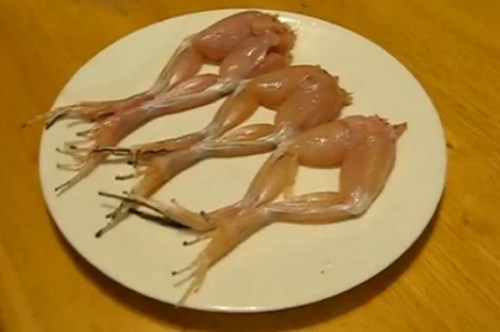Why do some animals still
Have you ever been shocked to see frog legs cut off but still moving? Why and why do not have a brain or nervous system but some parts such as body, legs . can "dance"?
What causes some animals to "dance" even if they are cut apart?
Despite skin peeling, all parts were removed, two frog thighs were not really " dead" . In these thighs there is still life and you can test it with a little salt. The sodium ions present in salt will act as stimuli that act like signals from the brain and nerves, causing a burning sensation. Because there is still energy in the cells, the frog's thigh muscles begin to twitch in response to the signal, causing the frog to 'dance' phenomenon .
Not only frogs but some animals also have this "strange" ability.

Sashimi, is a traditional Japanese dish whose main ingredients are fresh seafood. Viewers may be shocked to see chefs stealing fish but they can still swing, however the head-legged animal (cephalopoda) is a deadly mollusk, and movements after Preliminaries will be explained shortly.
People after death can still have random seizures and limbs can still be active for several hours after death, although this is caused by a mechanism different from the way the ink tentacles move when the body is cut.
The fish is still struggling and seems to try to escape when its head and intestine are removed.
So why is there no signal sent and received through the brain and nervous system, or the heart rate that tissues can still move? Although the brain and heart do not work, the cells can still respond to stimuli, such as adding sodium.
After death, motor neurons (the nerves that make mid-tissue movement), triggered by electronic signals, still contain some potential cell membranes (differences in concentration ion level).
All cells are polarized, which means the difference from low to high of charged molecules, or ions, inside the inner cells to the outside. The difference between concentrations is what makes the charge on the cell membrane.
The legs of the 'dancing' frogs after being soaked in salt, were posted by Thearchipelagos on Youtube channel.
When not activated by the nervous system, nerve cells maintain the capacity of the cell membrane by squeezing balanced ions of sodium and potassium (both of which are needed to stimulate the burning of nerve cells. sutra.
However, when nerve cells are activated with an electronic signal , separate channels between the open cell, allowing sodium ions to enter and when balancing the charge in the cell with the environment is essential. As a result, the potassium channels also open to make them spill out of the cell.
Eventually the channel closes and the neurons work to restore the balance between sodium and potassium concentrations inside and outside, but not before activating the nearby channels open, causing a reaction. chain in muscle.
This is basically how nerve cells make movement in a tissue.
A squid still moves the part with tentacles even though the chef cuts the body into slices.
As mentioned earlier, shortly after death, motor neurons still maintain some membrane capacity, or difference in ion charge, then start a chain reaction to the lines. leads nerves to cause movement.
The addition of sodium, in forms like table salt or soy sauce, will significantly increase reactions.
- Anatomical sight of a
- The woman is able to communicate with ... animals, including dead animals?
- Animals are 'facing' the danger of extinction
- The superhuman 'eyes' of animals
- Animals that are capable of being
- Top animals 'longevity' that you didn't expect
- Americans can eat meat if animals are killed by vehicles
- Ways of expressing the very 'human' emotions of animals
- Discovered 3 species of precious animals from the original ... time
- Do animals count like people?
- Fun fact about love story
- Bizarre mating of animals
 Animal 'suffering' after hibernation
Animal 'suffering' after hibernation Why do goats climb well?
Why do goats climb well? Scientists were surprised to see chimpanzees eating turtles
Scientists were surprised to see chimpanzees eating turtles Giant catfish died deadly due to drought in Thailand
Giant catfish died deadly due to drought in Thailand Good news: New cancer drug discovered that causes cancer cells to 'starve'
Good news: New cancer drug discovered that causes cancer cells to 'starve'  Why do we get older when cells are always replicating?
Why do we get older when cells are always replicating?  Shocking Research: Human Memory Doesn't Exist Only in the Brain
Shocking Research: Human Memory Doesn't Exist Only in the Brain  Reasons for easy weight gain: Obesity has 'memory' and retains mechanisms in cells
Reasons for easy weight gain: Obesity has 'memory' and retains mechanisms in cells  What happens to cancer cells after they die?
What happens to cancer cells after they die?  New Breakthrough: 'Hack' Tumors, Turn Cancer Cells Into Pills
New Breakthrough: 'Hack' Tumors, Turn Cancer Cells Into Pills 